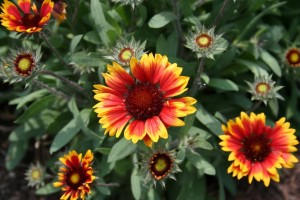This morning I went out to weed the flower garden before the heat soared, and encountered two unexpected visitors close up and in person. One resulted in a bee sting before I could withdraw my hand quickly enough from the patch of Gaillardia I was weeding. He got my just above the edge of my gardening gloves, about halfway up the arm, but I managed to whisk the bee off before the stinger penetrated too far, so aside from a bit of sting and redness I’m all set.
But then there was the wolf spider.
Do you have wolf spiders in your area? In North America there are 125 species and they are everywhere. They are the size of tarantulas. The body is about 1 to 2 inches long, and with the legs they’re about 4 inches long at maturity. Here is more information and photos of them: wolfspider.org
I surprise many in the garden. Today I tackled the weeds at the entrance to the garden path and the thousands of morning glories that seeded throughout the flowers beds near the entrance. I pulled up a stone, and a very large, very frightened wolf spider bolted out.
She carried the most exquisite turquoise-colored egg sac on her back. Wolf spider females carry their eggs with them in either a white or robin’s egg blue egg sac attached to the abdomen. Around my garden, many of the females have beautiful blue egg sacs ranging from the palest blue to a deep, rich robin’s egg blue. Today’s mama had a turquoise colored sac.
Wolf spiders do bite, but only if they mistake your finger for an insect. They prefer insects and mama spider was more interested in finding a safe rock to hide under than she was at biting me.
When the babies hatch, they cling to the mother’s back. It’s not uncommon for me to stop and wait while a mother wolf spider races across the road in front of us as I walk Shadow in the morning. I marvel at the hundreds of tiny babies waving their legs at me as if to say, “Thank you!” Sometimes I feel like a crossing guard.
No picture today of spiders. I’m not fond of looking at them myself. Instead, here’s the sunny face of a Gaillardia near where Mr. Bee got me.






Hope your sting is feeling better. We have wolf spiders in our garden. My husband almost sat on one the other day while picking strawberries. I haven’t seen the brightly colored sacs you describe. I will watch more closely.
I had to come back to tell you that I was out watering my strawberry plants when a wolf spider carrying an egg case went running out of the “rain.” She had a grayish white case bigger than her body.